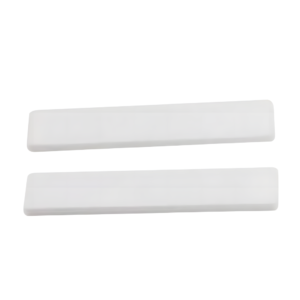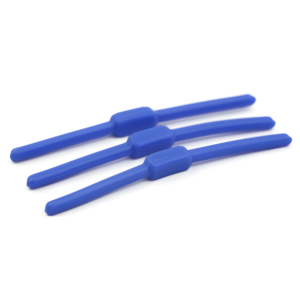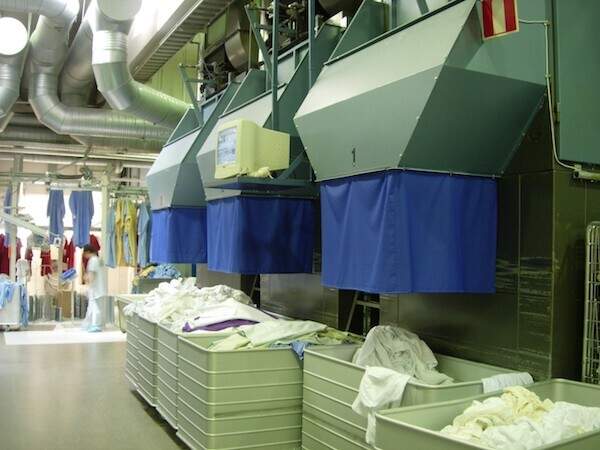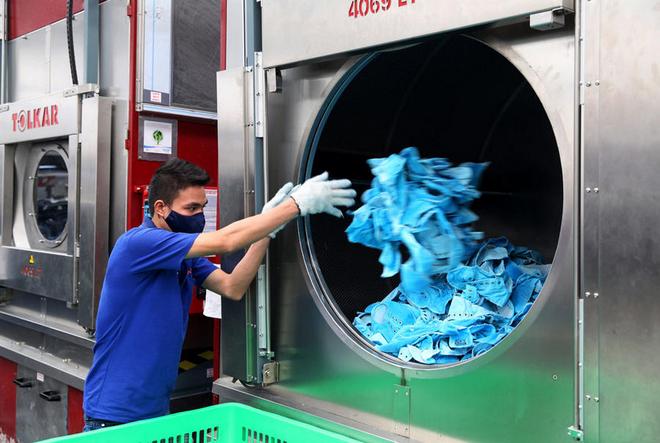
Hotels, hospitals, government units, garment factories and professional laundry companies have to deal with tens of thousands of work clothes and linen fabrics every year in terms of handing over, washing, ironing, finishing, storage and other processes.
How to effectively track and manage the washing process, the number of washing times, the inventory status and the effective classification of each piece of linen is a huge challenge. To solve the above problems, UHF RFID provides an ideal solution.
By embedding UHF laundry tags into the fabrics and binding the tag information with the information of the marked fabrics, and obtaining the tag information through the reader device, real-time tracking and management of the fabrics can be realized, forming the mainstream fabric rental management system in the market.
The pain points:
- a wide variety and a huge number of linen grass management is difficult, high management costs
- The processing of linen grass is complicated, and it needs smarter and faster management to effectively track each link.
- Managers need to visualize the management program to unify the management of all the linen, improve the utilization rate of the linen, reduce operating costs.
Solution:
The fabric laundry management system consists of UHF RFID laundry tags, RFID handhelds, channelizers, UHF RFID workstations and a fabric tag laundry management system.
The working steps of using UHF RFID linen management are:
- Sewing and registration: UHF RFID washing tags will be sewn to the fabric quilts, uniforms and other items, through the card issuer to write information into the RFID tag
- Handover: In the process of sending to the washing store for cleaning, the service staff will collect and pack the linens, and then pass through the tunnel machine, the RFID reader will automatically obtain the EPC number of each item, and transmit these numbers to the back-end system through the network, and then store the data, marking the items have left the hotel, and hand over to the staff of the washing plant.When the cleaned fabrics of the washing store are sent back to the hotel, scanning the channel through the RFID reader, the reader will get the EPC of all the fabrics and return to the back-end of the system to compare with the EPC data of the fabrics that are sent to the washing store, in order to complete the handover from the washing store to the hotel part of the work
- Internal management: Inside the hotel, the staff can use RFID handheld to complete the inventory of fabrics quickly, accurately and efficiently. At the same time, it can provide fast search function, track the status and location information of fabrics, and assist the staff to complete the work of taking fabrics. Through the statistical analysis of the background data, it can accurately get the washing situation and life span analysis of each single item of linen, which helps the management to grasp the quality of the linen and other key indicators. When the linen reaches the maximum number of washing times, the system can receive an alarm and remind the staff to replace it in time, in order to improve the service level of the hotel and enhance the customer experience.
RFID System User Benefits
- Using UHF RFID management system for automatic tracking and sorting can significantly reduce the manual labor of linen sorting and improve efficiency.
- Using accurate records of cleaning quantities, you can realize the management of the life cycle of the fabrics, and remind the manager to update the expired fabrics in time.
- Provide fast and easy visualization of inventory management. Visualized inventory inquiry can reduce the loss of fabrics and help to quickly retrieve the lost fabrics, thus reducing the hotel’s losses.
How to realize the whole process of RFID digital management of fabrics in hotels?

There are a lot of problems in traditional fabric management, such as fabric is easy to lose, difficult to track, and difficult to control the number of cleaning. Therefore, the realization of the entire process of hotel fabric RFID digital management has become an important task.
- Tag installation: the hotel needs to determine in which fabrics to install RFID washing tags. Generally speaking, hotels will choose to install tags on fabrics that are frequently used or need special tracking, such as bed sheets, towels and bathrobes. Then, the staff will install RFID wash tags on the fabrics to ensure that the tags are securely installed and do not interfere with the use and cleaning of the fabrics.
- Data entry: Each fabric with an RFID laundry tag is entered into the system and associated with its unique identification code (RFID number). In this way, when the cloths enter the washing process, the system is able to accurately identify and track the status and location of each piece of cloth. During this process, the hotel will create a database to record information about each piece of fabric, including type, size, color, location, and so on.
- Cleaning process: After the cloths are used, the staff will collect them and send them to the cleaning process. Before entering the cleaning equipment, RFID washing tags will be recognized and recorded in the system so that the location and status of the cloths can be tracked at any time. The cleaning equipment will execute the appropriate cleaning procedures according to the type and status of the cloths, and re-record the information of the RFID washing tags after the cleaning is completed.
- Tracking and Management: Throughout the cleaning process, hotel managers can track the location and status of fabrics in real time through RFID readers. They can view the information of the fabrics that are being cleaned, have been cleaned and completed, and need to be repaired or replaced. In this way, managers can make corresponding scheduling and decision-making according to the actual condition of the fabric to ensure the supply and quality of the fabric.
In addition, in order to realize the whole process of RFID digital management of the hotel fabric, the hotel also needs to strengthen the staff training and management. Employees need to learn how to properly use RFID equipment, how to correctly identify and process the information read by RFID, and how to cooperate with the information system for fabric management.
At the same time, the hotel also needs to establish a perfect fabric management system and process, clear responsibilities and authority of each link, to ensure that RFID digital management can be effectively implemented.
How long does it take for a hotel to pay for itself by tracking its cloth with RFID?
In order to meet customer expectations for high quality service, hotels must ensure adequate supply of fabrics, accurate inventory control and efficient communication. the fabric tracking feature introduced by HID provides a new fabric management solution for five-star hotels, helping them to realize efficient and accurate fabric management, reduce costs and improve operational efficiency.
Royal Jersey Laundry, as one of the five-star hotel partners, is the first to adopt HID’s RFID fabric management platform. This innovative technology replaces the traditional paper-based system and realizes end-to-end tracking from washing to collection. By deploying Lintrak RFID tags and Acuity software, the Royal Jersey Laundry successfully realized accurate counting and automatic billing of fabrics. This system not only reduces human error, but also improves productivity and efficiency and reduces labor costs.
The application of RFID technology makes fabric management more intelligent. Laundry and room service staff can easily identify the type, quantity and usage status of fabrics through RFID tags for better inventory management. In addition, through integration with Sage accounting software, the laundry is able to automatically generate accurate invoices, further improving the efficiency of financial management.
Since installing the HID equipment in 2019, the system has paid for itself due to increased efficiency and productivity. Laundry and room service staff no longer waste their time on boring and resource-intensive activities such as manually counting fabric. They are redeployed to more productive tasks, saving 10-20% in labor costs.
Additionally, because hotels know exactly where and how much fabric is available, they are better able to meet peak demand and reduce fabric expenses by up to 30%. although fabric theft in 5-star hotels is rare, it does happen. RFID tags allow for better monitoring of expensive bedding and towel investments. Operations are more efficient because items tracked with RFID are rarely lost or misplaced.
RFID’s fabric tracking capabilities provide the hospitality industry with an efficient and accurate solution for fabric management. By adopting RFID technology, laundries achieve intelligent management of their cloths, reducing costs and increasing productivity. At the same time, hotels are able to enjoy better operational benefits, enhancing customer satisfaction and competitiveness. In the future, with the continuous progress of technology and popularization of application, the cloth tracking function of RFID is expected to play a more important role in the hotel industry.



Brazilian Hospital Uses RFID to Track 158,000 Bed Linens

Brazilian nonprofit Hospital Israelita Albert Einstein is using RFID technology to digitally manage large quantities of bedding, from sheets to towels and pillowcases used by patients, resulting in significant savings.
This solution allows healthcare providers to track the use, cleaning and recycling of bedding, ensuring that inventory is well-stocked and efficiently replenished. In addition, this solution takes a fraction of the time of a manual system, saving approximately $300,000 per year.
Tracking Bedding in a Complex Supply Chain
Hospital Einstein in São Paulo, Brazil, is an 800-bed healthcare facility that spans 273,000 square meters across multiple city blocks. To serve its thousands of patients, the hospital has 150 bedding lockers that need to be replenished four times a day. According to Rafael Vitolo, the hospital’s RFID program manager, there are 35 different sizes and models of the approximately 158,000 bedding items.
Each storage area or cabinet has a minimum inventory requirement. Sheets and pillowcases are higher during the morning shift; another minimum level is set for the evening shift.
The sheer size of the hospital and the ever-increasing number of storage areas forced the previous staff to make frequent trips between sites and perform tedious manual inventory checks.
In addition, all bedding was washed in an external laundry approximately 50 kilometers from the hospital, which further complicated the bedding supply chain.The hospital wanted to use RFID technology to improve the logistics of bedding from patient to laundering to storage. They began using the technology in the second half of 2022 and spent about five months analyzing the results to determine the expected return on investment.
The specifics of the solution are as follows:
The bedding supplier affixed passive UHF RFID tags to shipments destined for the hospital. These tags are encoded with a unique ID that is associated with the corresponding item in the RFID software.
“Every time we purchase new bedding, we give the RFID tags to the manufacturer, and before they tag and deliver the product to us, we attach the tags to the product for immediate use.” Renata Santos, the hospital’s bedding coordinator, explains.
When washed and ironed bedding arrives at the hospital from an outside laundry, it passes through an RFID door reader to read all of the tags’ information. The software provides data on the cabinets that need to be replenished as well as the inventory available in the receiving area of the “laundry room”.
Bedding is then assigned to the appropriate cabinets based on the supply quantities provided by the software. When the cabinets have been replenished, staff reads all tags using a handheld reader. The user can view the results of the replenishment count.
Handheld readers are deeply integrated with read/write cabinets
After bedding items are used, they go through the laundry room to update their status again before being sent to an external laundry service.
Hospital team members can review supply data and then create replenishment cards (written orders) based on each cabinet’s needs.
“For each new replenishment, we need to scan the location using an RFID reader so that the system can generate a replenishment demand based on the minimum inventory information that should be in that location.” Vitolo said.
Hospital employees use 12 TSL portable RFID readers, each connected to a smartphone via Bluetooth. The hospital has two Datamars RFID cabinets in the busiest areas equipped with Impinj readers for real-time data updates. As items are removed from the cabinets, inventory quantities are automatically updated.
SmartxHub data includes not only the middleware used to interpret RFID tag reads, but also the Smart Hub app and Smart Hub Web, which allows users to view data online or via cell phone.
Reduced labor costs
Since the system was put into use, the hospital has been conducting a full inventory count every two months, and the count time has been reduced from 72 hours to 10 hours. On average, the hospital was able to save 30 minutes of work time per bedding supply person per day. By reducing labor hours by approximately 6,000 hours per year, the hospital is expected to realize a financial gain of approximately $29,000 per year just by reducing labor costs.
The system also allows the hospital to recognize when items are damaged, abused or in need of replacement.
Since the technology has been put in place, bedding losses have been reduced from 4 percent of the total to 0.8 percent, while inventory accuracy has improved, Vitolo says. Another benefit: a 12% reduction in water usage in the external laundry and a reduction in electricity consumption of 139,000 kWh per year.
As a result of all these benefits, the hospital realized a financial gain of approximately $300,000 in 2023, according to Vitolo’s report.
Garment Manufacturer Uses RFID for Dry Cleaning Management on Production Line
A well-known apparel production enterprise has designed a management system based on RFID tags. This system to RFID tags as the core, the use of RFID middleware, the realization of advanced RFID technology and clothing management methods of organic fusion.
By combining RFID tags with the enterprise clothing ERP management system, it provides an efficient technical means for the production management of clothing enterprises. This not only improves the efficiency of production line management, simplifies the process of clothing management, but also reduces the labor intensity of management personnel, and provides consumers with a more fashionable and convenient shopping experience.
In terms of laundry management, the goal of RFID laundry management system is to assist in the management of laundry work in the handover, inventory, washing, ironing, folding, finishing and storage. By utilizing the characteristics of laundry RFID tags, the system is able to track and manage the washing process of each piece of apparel, record the number of washings, washing parameters, and expand the application areas.
At present, the laundry industry counts and records completely rely on manual labor, which not only increases labor costs, but also may result in data errors, which may lead to unnecessary losses or disputes. For example, the dry cleaning factory clothing recovery will be more messy, and the return of manpower is still needed to sort. After the introduction of RFID technology, RFID equipment through the automatic reading of RFID tags, you can realize the batch inventory, washing tracking, automatic sorting and other functions, thereby improving the efficiency of laundry management, dry cleaners to provide a more advanced and controllable services, increase the market competitiveness of the washing business.
The introduction of RFID radio frequency identification technology will make the user’s laundry management become more transparent, improve work efficiency, and solve the management problems that could not be realized by other technologies in the past.
Product identification: by sewing button mounted RFID tags on each piece of laundry to identify each piece of clothing. unique ID number in the RFID smart tag chip, as well as the user area for writing data, you can write the specific properties of the clothing within the label, such as the owner of the clothing, the life of the clothing, the number of times and model of the washing.
Automatic counting: Divided into receipt counting and issue counting, it allows for accurate accounting of the quantity of each handover. For packed dirt, the whole package can be counted by RFID tunnel reading equipment, with an accuracy rate of up to 100%. These data are objective and scientific, and can be checked with the user for the number of handovers. At the same time, ready to return to the user’s clean clothes also through the RFID tunnel reading equipment to confirm the exact number and list.
Automatic sorting: Because the enterprise and the user is through the manual handover of clothing, so through the uniqueness of RFID tags in the washing plant to realize the automatic sorting of clean clothes, directly sorted to the smallest user unit and packaged list, which can save manual sorting time, reduce the labor intensity of personnel.
Record of washing times: Due to the characteristics of RFID tags, the number of washing times can be recorded, predicting the life of the clothing, reasonable control of clothing inventory, to provide users with more scientific services.
RFID (electronic tags, radio frequency identification) technology in the apparel industry can be applied to production, distribution, retail and other aspects. Unlike other ID identification technologies, RFID technology allows multiple tags to be read at the same time, and each clothing tag is tracked by the system.
Using the system benefit:
- Labor costs can be reduced by 40-50%.
- More than 99% of clothing products are visualized, reducing the risk of clothing loss.
- Improved supply chain management will reduce work service time by 20-25%.
- Improve the accuracy and reliability of storage information.
- Efficient and accurate data collection to improve operational efficiency.
- Automatic data collection for distribution and recycling handover reduces human error.


